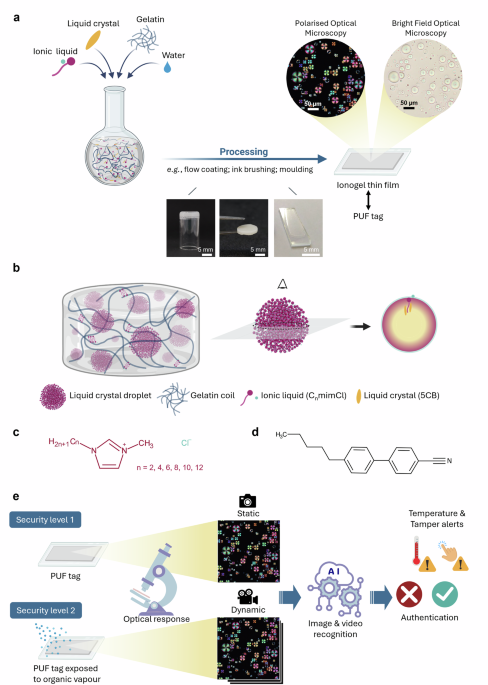Hidden rainbows in gelatin help preventing counterfeiting
Published in Materials, Sustainability, and Computational Sciences

Have you been scammed when purchasing a product? Did you realise that you bought a pig in a poke?
Well, you are not alone. Unfortunately, counterfeit products are prevalent, and a parallel market for fake and adulterated products has even emerged. It includes all sectors, from clothes and cosmetics to pharmaceuticals. In Europe, almost 5% of imports were counterfeit products in 2021, corresponding to €99 billion in value.
To protect their brands and the clients, the industry uses authentication tags. Current tag options like radio frequency identification (RFID) tags and holograms are not 100% safe because they can be cloned or falsified, due to their predictable production methods.
Physical unclonable function (PUF) tags are authentication tags fabricated by stochastic methods and are impossible to clone or fake, like a fingerprint. Not even the manufacturer can fabricate two identical PUF tags! Unfortunately, PUF tags still face limitations, including low sustainability of materials and fabrication methods, complex verification instruments, reduced durability and scalability.
Hidden rainbows in gelatin
We discovered that gelatin has uses beyond making a tasty dessert. When combined with light-modifying agents, like liquid crystals, gelatin can be used to fabricate sustainable PUF tags with hidden rainbow-like optical fingerprints. Our PUF tags are extra secure – they have two levels of authentication derived from the optical and stimuli-responsive characteristics of the gelatin-based materials.
In this paper, we present the C12 PUF tags, made from an optically active gelatin-based ionogel film that can be applied as an ink or as a pre-assembled tag on objects. The tags are invisible to the naked eye due to their millimeter-range size and transparency. C12 PUF tags are composed of 80% biodegradable materials, stable up to 2 years, and the fabrication methods are mild and scalable. The authenticity verification can be done with a microscope or translated to more user-friendly equipment, such as a smartphone.
When observed under a polarized optical microscope (POM), the tags exhibit rainbow-like droplets, forming random and colored patterns that are different in every tag.

Each tag´s POM image is unique and impossible to reproduce. This is the first level of security of the envisaged PUF tag system. A second level of security will use the gas-responsive character of the gel, which consists of a dynamic change of the native pattern of the tag when exposed to an organic vapor (see the video below). Authenticity verification will be straightforward with an AI-driven image recognition system stored in the Cloud, to offer superior security.

In this video se can see the dynamic change of the C12 optical pattern when exposed to vapours of acetone. This behaviour is impossible to clone and will be the basis for the second authentication level of the PUF tags.
The team behind
Our team at UCIBIO (Applied Molecular Biosciences Unit) in NOVA School of Science and Technology has been working on gelatin-based optical materials since 2014. This research was funded by the SCENT ERC Starting Grant, awarded to Professor Cecília Roque to develop gas-sensing materials for electronic noses. The C12 PUF tags emerged as an unexpected application of the materials developed by Susana Palma in the scope of SCENT, with the help of Emi Ramou for the optical characterization. The PUF tag ideia is now being explored in detail in the SUBTLE project, funded by the Portuguese Foundation for Science and Technology and recently IP-protected. Stay tuned to our work and future developments.

Follow the Topic
-
Communications Materials

A selective open access journal from Nature Portfolio publishing high-quality research, reviews and commentary in all areas of materials science.
What are SDG Topics?
An introduction to Sustainable Development Goals (SDGs) Topics and their role in highlighting sustainable development research.
Continue reading announcementRelated Collections
With Collections, you can get published faster and increase your visibility.
Advanced characterizations of high-entropy materials
Publishing Model: Open Access
Deadline: Dec 31, 2025
Multifunctional hydrogels
Publishing Model: Open Access
Deadline: Feb 28, 2026

Please sign in or register for FREE
If you are a registered user on Research Communities by Springer Nature, please sign in